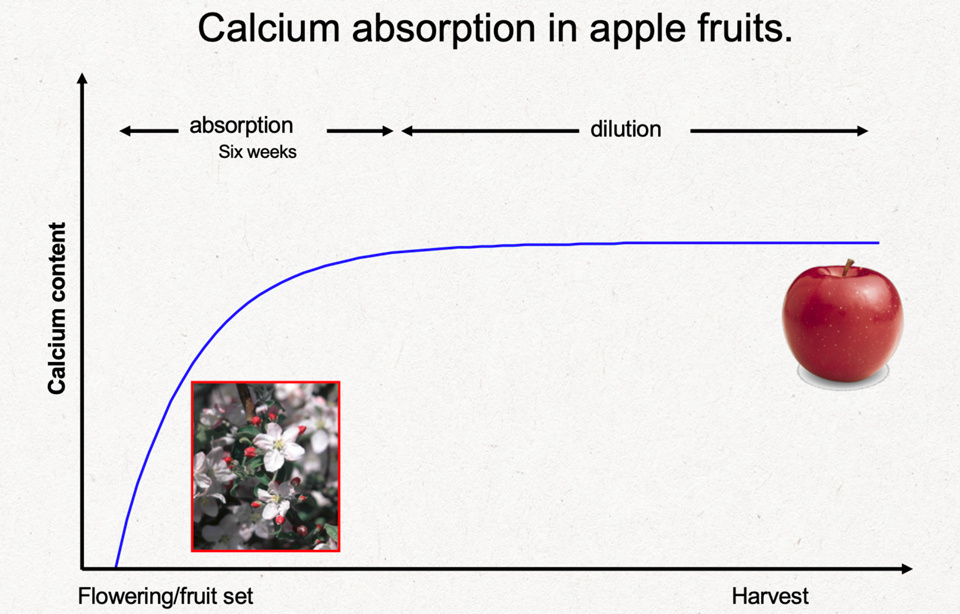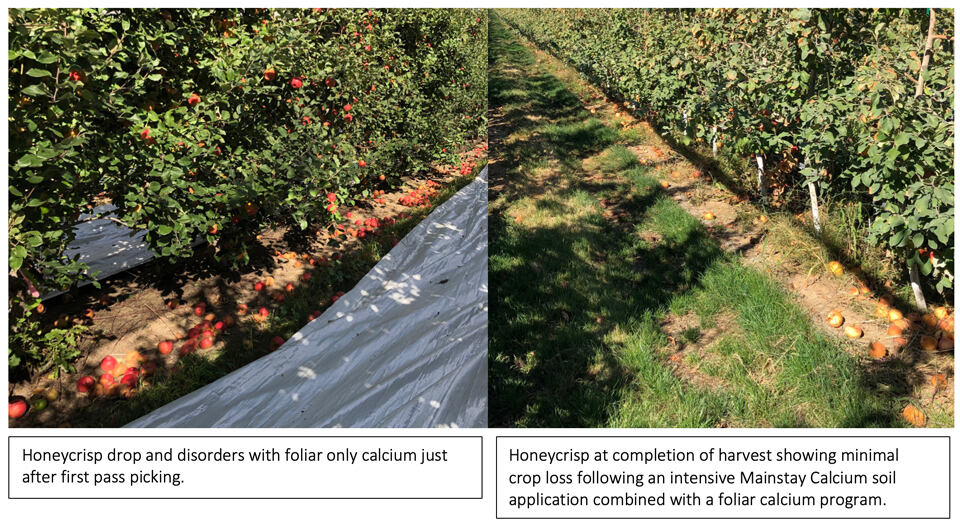By:
Mainstay Calcium is the only soil applied calcium on the market that is highly plant available. This provides a unique opportunity to sharply improve calcium nutrition during cell division in permanent crops. In pome fruits, the uptake or “absorption” phase (depicted below) occurs from fruit set through 6 weeks. This is when fruitlets are actively transpiring and using water and nutrients delivered by the xylem. Without supplemental application, soil calcium availablility is often poor. Fruit will not receive enough calcium during this critical time to prevent quality problems such as bitterpit, cork spot, stem bowl cracking, etc. Targeted applications of Mainstay Calcium during cell division are the key to reducing or eliminating calcium related crop loss.

The Uptake Curve
Note that calcium uptake just after fruit set is rapid and strong (see graph). As cell division draws to a close, the curve begins to flatten. Ideally applications should target the steepest part of the curve.
Rates
Typical cell division rates are a total of 5 to 10 gallons per acre divided into weekly or biweekly applications. Application through drip irrigation is most often a weekly schedule. Spray down applications are typically a bi-weekly schedule. Use higher rates on susceptible varieties and hotter sites with a history of condition problems. Note that heavy crops are less likely to have calcium related problems while lighter crops may require more aggressive rates.
Root Growth
Soil calcium is bound on soil colloids and its uptake requires active root growth. Elemental calcium is released into the soil solution and taken up by the plant immediately in response to acidification of the microclimate around an active root tip. This early root growth is dependent on soil temperatures of 55 – 60 degrees.
In contrast, microencapsulated Mainstay Calcium remains free in the soil solution for immediate uptake by roots in response to transpirational demand by the plant. This is a tremendous advantage in permanent crops where early fruit set and cell division often occurs before soils warm sufficiently for root growth to begin.
Irrigation
Early season soil applications should be timed with irrigation to water them in.
– Short irrigation sets or injection during the last hour or two of a drip application will keep the calcium close to the surface where early root growth is most active.
– Frost control water will keep the soil cool slowing root growth and may also drive the calcium past the root zone. Delay application until petal fall or until risk of frost has past.
– Pre-bloom irrigations that keep soil cold are not uncommon. In blocks that receive early irrigation, a quick check for actively growing roots near the trunk will determine when to start calcium application.
– If irrigation is not available until post bloom, delaying applications to anticipate water availability is advisable.
– Over irrigation early in the season and high volume overhead cooling water later may reduce calcium uptake.
Soil texture
Mainstay Calcium moves freely in the soil solution. When applied to coarse soil smaller more frequent applications produce better results. In loamy soil, less frequent but higher volume applications work well.
Soil pH
An acidic imbalance in soil pH can severly limit air/water relations, root growth and calcium availability. Correcting pH with lime is an essential component of plant health and optimal calcium uptake.
Cultivar
Each cultivar has its own calcium requirement. For example, most apples and pears will partition xylem supplied calcium effectively during cell division. Mainstay Calcium applications just during this six week period are often sufficient. Honeycrisp is less effective at partitioning calcium to the fruit. Mainstay Calcium applications on Honeycrisp should be emphasized during cell division but continued season long, particularly on warmer sites.
N, Mg, K
High levels of these three nutrients when plant available in the soil will require increased rates of calcium to offset.
Vigorous growth
High vigor will increase the likelihood of calcium disorder risk. Higher rates of calcium may be required to offset.
Zinc and Boron
These elements play a critical roll in cell division and calcium uptake and utilization. Triplex Micro and Triplex Zinc are reacted to remain plant available in the soil and can be added to applications of Mainstay Calcium.
Fruit Drop
Intensive Mainstay Calcium decreases fruit drop and crop loss in Honeycrisp as depicted below.

Note: In some cases crop loss due to calcium related disorders is catastrophic. This can happen in any cultivar but has been most often observed in Honeycrisp in the recent past. Although calcium inputs play a role, management of irrigation and balanced nitrogen, Mg, and K fertility are critical to successful crop quality. Calcium nutrition alone cannot overcome severe imbalances with these inputs.
Contact your local Redox representative with questions
Questions? Want to know more about Mainstay Calcium – Xylem Supplied Calcium for Cell Division?
Subscribe to receive our Redox Bio-Nutrients updates